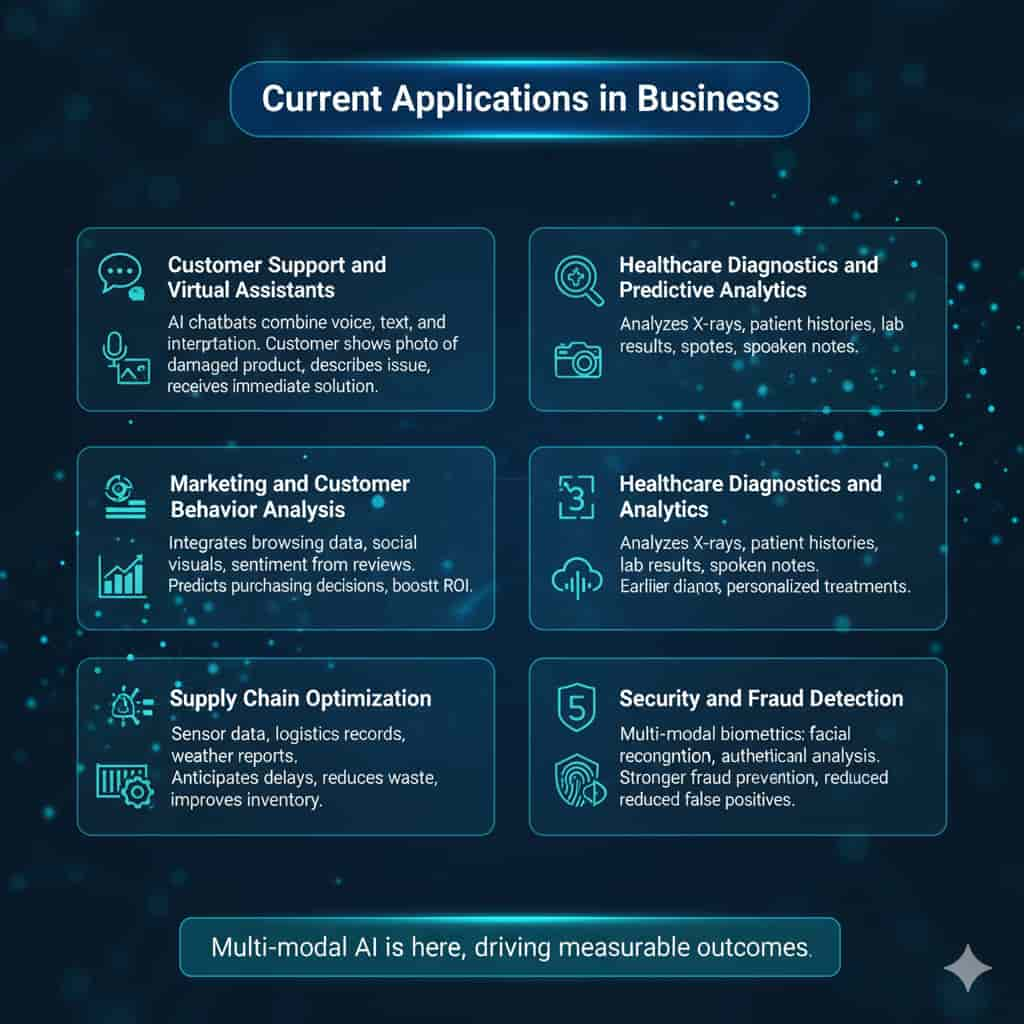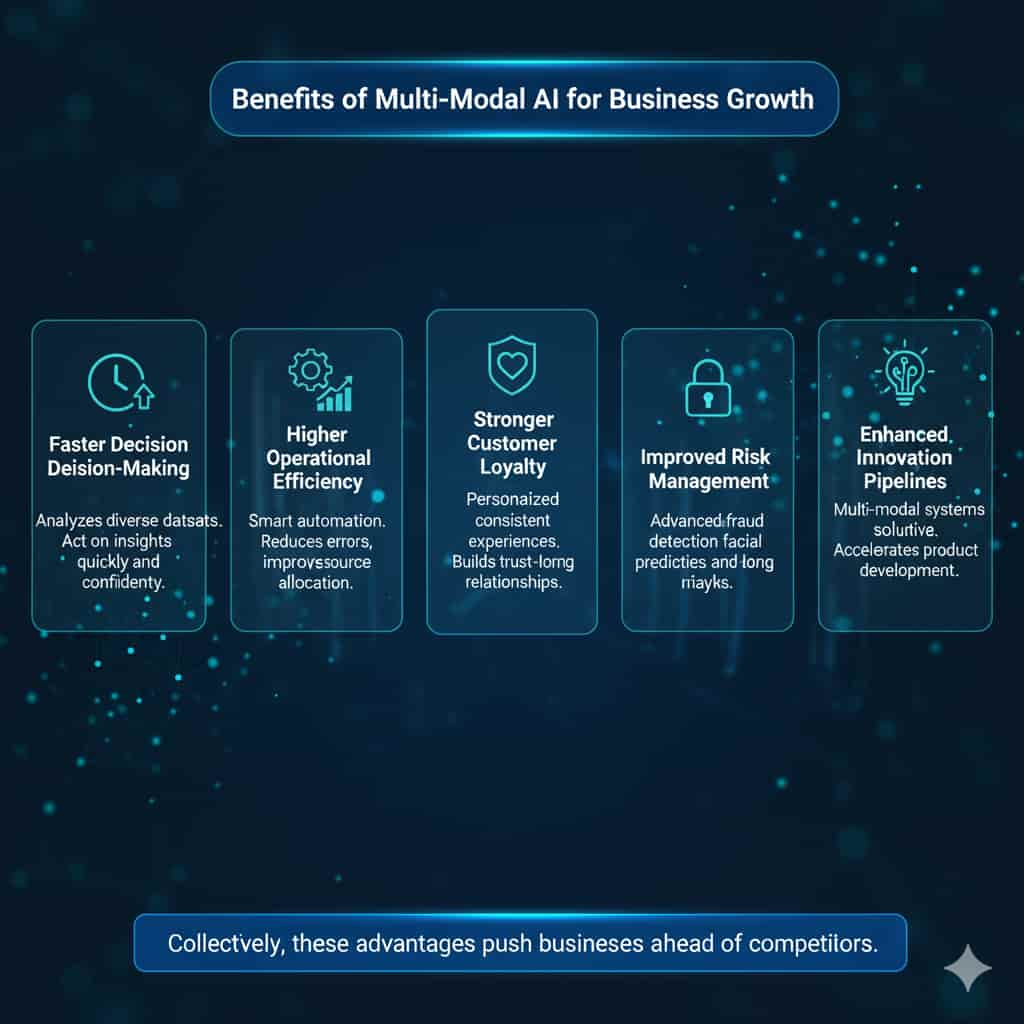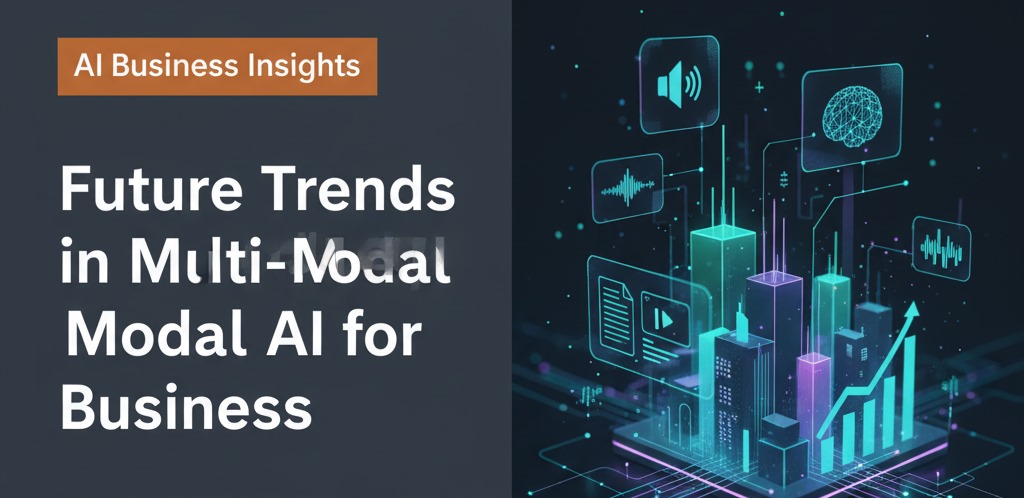Introduction
Artificial intelligence is progressing beyond the analysis of images or text alone. To produce more intelligent insights, multi modal AI combines language, vision, sound, and even sensor data. In the upcoming years, this change will present businesses with new opportunities to enhance customer experiences, optimize operations, and unleash innovation at scale.
What is Multi Modal AI?
Artificial intelligence systems that can process and comprehend several kinds of data at once are referred to as multi modal AI. Multi modal AI integrates data from various sources to create a more comprehensive understanding rather than concentrating on a single input type, like text or images.
Consider the way that people learn, for instance. When you watch a video, you pay attention to the speaker’s tone of voice, gestures, and facial expressions in addition to the words being spoken. To interpret meaning, your brain combines all of these signals. Similar to this, multi modal AI integrates text, images, audio, video, and even sensor data from IoT devices.
Because of this, it differs greatly from conventional, single modal AI, which only handles one type of input at a time. For example, a text based chatbot may be able to comprehend written text but not an attached image. An object in a picture could be recognized by a vision-only model, but it would have trouble describing its context in natural language.
AI systems can produce more accurate, contextually aware, and human like responses and insights by combining various modalities. They can more naturally interact across platforms, identify subtle patterns, and respond to inquiries about complex scenarios. This all encompassing strategy is a significant advancement in AI development and has important ramifications for companies looking to gain a competitive edge.
Why Multi Modal AI Matters for Businesses
Businesses thrive on making informed decisions, delivering personalized experiences, and scaling operations efficiently. Multi modal AI plays a vital role in enabling these goals.
First, it enhances decision making. By pulling in diverse data streams customer conversations, behavioral analytics, product usage metrics, and even visual content leaders can uncover deeper insights. For example, analyzing both call transcripts and customer sentiment from facial cues in video support calls offers a clearer picture of client satisfaction.
Second, it boosts personalization. Today’s customers expect seamless, tailored interactions across channels. Multi modal AI enables context aware recommendations that blend browsing history, voice commands, and visual preferences. A retail app, for instance, could suggest products based on a combination of spoken queries, past purchases, and shared photos.
Third, automation becomes smarter. Virtual assistants powered by multi modal AI can not only respond to text or voice but also analyze documents, identify images, and process real-time IoT data. This significantly expands the scope of tasks they can handle, from supply chain monitoring to fraud detection.
There is no doubt about the competitive advantage. Businesses that use multi modal AI can innovate more quickly than those that use single modal systems, provide better customer experiences, and react to changes in the market more quickly. Businesses that lag behind may find it difficult to meet changing industry standards and customer expectations as adoption increases.
Multi modal AI is not merely another incremental technology, to put it briefly. Connecting business intelligence, customer engagement, and operational efficiency into a single, integrated ecosystem is a revolutionary leap.
Key Current Applications in Business
Multi modal AI is not yet reshaping industries today. Some of its most impactful business use include:
1. Customer Support and Virtual Assistants
AI powered chatbots now combine voice recognition, text analysis, and image interpretation to deliver more natural interactions. A client could show a photo of a ramshackle product, describe the issue verbally, and receive an immediate solution.
2. Marketing and Customer Behavior Analysis
By integration browsing data, social media visuals, and feeling from customer reviews, businesses can forebode purchasing conclusion more accurately. Campaigns become more relevant and engaging, boosting ROI.
3. Healthcare Diagnostics and Predictive Analytics
In healthcare, multi modal AI helps doctors by analyzing X-rays, patient histories, lab results, and even spoken notes. The collection leads to earlier diagnoses, personalized attention, and improved patient care.
4. Supply Chain Optimization
Sensor data from IoT devices, combined with logistics records and weather reports, enables commerce to anticipate delays, reduce waste, and better inventory management. This results in cost savings and smoother operations.
5. Security and Fraud Detection
Multi modal biometrics, such as combine facial recognition with voice authentication and analysis, make fraud prevention stronger. In finance, this multi layered approach improves accuracy and reduces false positives.
These examples demonstration that multi modal AI isn’t a far off concept. It is not yet here, driving measurable outcomes in industries where efficiency, accuracy, and customer experience matter most.

Future Trends in Multi Modal AI for Business
5.1 Enhanced Customer Experience
The future of client engagement lies in hyper personalization. Multi modal AI will make recommendations not only based on text or clicks but also on voice tones, mental image shared, and even emotional cues. Imagine a customer service platform that detects frustration in a caller’s tone of voice while analyzing their purchase history to offer faster mixture.
5.2 AI-Driven Creativity
Businesses will soon rely on AI to generate marketing content, design products, and create multimedia system assets. Multi modal systems can analyze consumer trends, competitor visuals, and brand voice to craft campaigns that feel caller and human. For instance, AI could design an ad that adapts in real time based on audience reactions.
5.3 Seamless Human AI Collaboration
Workplaces will adopt AI assistants capable of interpreting speech, gestures, and visuals to assist decision making. This could look like a digital co pilot in sports meeting that transcribes discussions, highlights relevant data, and provides instant insights all through multi modal inputs.
5.4 Integration with IoT and Edge AI
As industries connect more devices, multi modal AI will bridge data from IoT sensors, cameras, and functional systems.
In manufacturing, it could spot instrumentation issues by analyzing vibration patterns alongside visual inspections, all in real time at the edge.
5.5 Advanced Security and Compliance
Security will evolve with AI that verifies identity through multiple signals: face, voice, typing patterns, and even environmental context. Multi modal noncompliance systems will also help businesses detect ab normalcy and maintain trust in regulated industries.
5.6 Industry-Specific Transformations
- Retail: Smarter product recommendations and immersive shopping experiences.
- Finance: More accurate fraud detection and customer verification.
- Healthcare: Faster diagnoses and predictive patient monitoring.
- Manufacturing: Safer operations with predictive maintenance.
- Education: Personalized, interactive learning powered by AI that understands text, visuals, and student behavior.
These trends highlight a world where multi modal AI becomes woven into the fabric of everyday business, heighten both back end processes and customer facing interactions.
Benefits of Multi Modal AI for Business Growth
Multi modal AI is more than just a tech upgrade it’s a growth driver.
Its benefits include:
- Faster Decision-Making: By analyzing diverse datasets, businesses can act on insights quickly and confidently.
- Higher Operational Efficiency: Smart automation reduces errors and improves resource allocation.
- Stronger Customer Loyalty: Personalized, consistent experiences build trust and long term relationships.
- Improved Risk Management: Advanced fraud detection and predictive analytics minimize risks.
- Enhanced Innovation Pipelines: Multi modal systems inspire creative solutions and accelerate product development.
Conjointly, these advantages can push businesses ahead of competitors in both efficiency and customer dissatisfaction.

Challenges and Risks of Multi-Modal AI
Despite its promise, follow multi modal AI comes with hurdles:
- Data Privacy and Regulation: Handling sensitive data from multiple sources raises compliance challenges.
- Integration with Legacy Systems: Many enterprises struggle to connect AI with outdated infrastructure.
- High Costs: Training and deploying multi modal systems requires powerful computing resources.
- Bias and Misinformation: AI trained on flawed data risks amplifying errors or biases.
- Workforce Skills Gap: Employees need new skills to work effectively with advanced AI tools.
Adjudge these challenges helps business organization prepare realistically and adopt responsibly.
How Businesses Can Prepare for Multi Modal AI
8.1 Assess Current AI Maturity
Start by evaluating how AI is presently used. Identify strengths, gaps, and chance for multi modal integration.
8.2 Invest in Infrastructure
Build strong data grapevine, adopt scalable cloud or edge computing, and secure networks to handle complex AI workloads.
8.3 Upskill Workforce
Provide targeted training for executives, data field, and frontline teams. Encourage a culture of continuous learning.
8.4 Partner with AI Vendors and Startups
Collaboration speeds up innovation. External partners bring expertise, while startups offer agility and niche solutions.
8.5 Create Ethical and Governance Frameworks
Develop line of reasoning to ensure AI is used responsibly, fairly, and transparently. This includes addressing bias, accountability, and conformity.
By taking these steps now, businesses can position themselves to adopt multi modal AI smoothly and strategically.
Read more: The Future of AI: Trends You Can’t Ignore | Multimodal AI …
Case Studies: Early Adopters of Multi-Modal AI
Case Study 1: Retail Industry
Multi-modal AI was incorporated into customer service by a global e commerce company. It greatly increased customer satisfaction ratings and cut down on resolution times by 40% by examining voice calls, chat messages, and product photos.
Case Study 2: Healthcare Sector
A leading hospital adopted multi modal AI for diagnostics. The system combined radiology images, patient histories, and spoken notes from doctors to suggest potential diagnoses. This reduced misdiagnoses and improved treatment speed.
Case Study 3: Finance Industry
A bank combined transaction behavior, voice biometrics, and facial recognition to implement multi modal fraud detection. The number of fraudulent attempts decreased by 60%, and legitimate customers had easier access.
These instances show how early adopters are influencing future best practices and reaping quantifiable returns.
Read more: The Rise of Multimodal AI Agents: What You Need to Know
The Road Ahead: Predictions for the Next 5–10 Years
Multi modal AI will develop further and become more widely available in the upcoming ten years. Through edge AI, models will develop to manage bigger, more complicated datasets while operating effectively on smaller devices.
Advances in generative AI will allow systems to produce new types of content in real time in addition to analyzing data. AI may be used to create whole product lines, individualized lesson plans, or remarkably accurate business scenario simulations.
Global industries will eventually transition to AI first operations. While late adopters run the risk of lagging behind, businesses that adapt early will lead in efficiency, customer satisfaction, and innovation.
Read more: Top 5 Powerful Steps for AI Content Quality Assurance
Frequently Asked Questions (FAQ)
What makes multi modal AI different from traditional AI?
Traditional AI usually handles one data type at a time, like text or images. Multi modal AI combines multiple data streams, such as speech, visuals, and sensor inputs, for richer, more accurate insights.
Which industries will benefit most from multi modal AI?
Healthcare, finance, retail, manufacturing, and education are among the biggest beneficiaries due to their reliance on diverse data types.
How does multi-modal AI impact customer personalization?
It allows businesses to understand customers more holistically, blending voice, behavior, and visuals for deeply personalized interactions.
What are the major risks of adopting multi modal AI?
Privacy concerns, high costs, bias, and integration difficulties are common challenges.
How can smaller businesses use multi modal AI?
They can adopt AI through cloud-based services or partnerships with startups, reducing upfront costs while accessing advanced capabilities.
Will multi modal AI replace human jobs?
It is more likely to augment rather than replace jobs, handling repetitive tasks while enabling humans to focus on creativity and strategy.
How is multi modal AI connected to generative AI?
Generative AI can be multi modal, creating text, images, or video by combining inputs from different modalities.
What is the cost of implementing multi modal AI in business?
Costs vary based on scale, but cloud services and pre-built solutions are making adoption more affordable.
How can businesses ensure ethical use of multi modal AI?
By creating strong governance frameworks, monitoring bias, and ensuring transparency in AI decision making.

